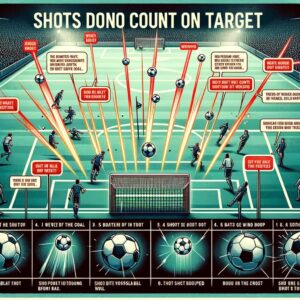In the world of soccer, where every player on the field strives to score goals, the concept of shot on target soccer betting has gained immense popularity. As a seasoned follower of the sport, I’ve observed this trend, witnessing firsthand the exciting moments when a striker or even a goalkeeper makes a daring attempt to send the ball flying into the back of the net. The thrill of predicting these moments has made goal betting a popular activity among fans. From a yard out or even 30 yards away, the anticipation of whether the effort will pay off is a major part of the appeal.
In this dynamic betting market, the key is understanding not just who will score, but also the intricacies of shots on target. It’s not just about the striker or the poacher tapping in a squared ball; it’s about recognizing the objectives and roles of all 11 positions on the pitch.
This deeper insight, which I’ve developed over years of watching and analyzing games, greatly works in one’s favor when engaging in shots on target betting. While there are alternatives to this type of bet, its growing popularity suggests it’s more than just a fad—it’s an integral part of the modern soccer experience.
What Is a Shot On Target?
In soccer, a shot on target is defined as a moment where the ball potentially changes the score. It’s an instance where the ball either goes into the back of the net, showcasing the successful intent of a player to score, or it’s a clear attempt that gets blocked. The latter can involve the goalkeeper or a player acting as the last man — a scenario often referred to as a last line block. As someone who has watched countless games, I’ve seen many shots that seemed destined for the net, only to be thwarted at the last second by a crucial save or block.
But, not every shot that’s stopped counts as a shot on target. A blocked shot by someone not deemed the last man, especially when there are others behind him, doesn’t qualify. This distinction is important for understanding game dynamics and statistics. Similarly, if the ball hits the frame of the goal and doesn’t go in, it’s not a shot on target. However, if it strikes the frame and ends up in the net, being awarded as a goal, it’s counted as a shot on target. These nuances often lead to spirited debates among fans and analysts alike.
Understanding what constitutes a shot on target adds depth to how we view and analyze the game. It’s not just about the number of shots, but their quality and potential to change the game. As a fan and observer, recognizing these moments adds an extra layer of excitement and appreciation for the skills and strategies at play on the pitch.
What Is a Shot Off Target?
In soccer, a shot off target is defined as an effort by a player that doesn’t result in a goal, mainly due to it going over or wide of the goal. This includes shots that miss the mark without making contact with any other players. If it’s stopped by an outfield player or a goalkeeper’s save, it’s still considered off target. Similarly, a shot that hits the frame of the goal but does not end as a goal is also categorized as a shot off target. This distinction is crucial in analyzing game strategies and player accuracy.
How Does Shots on Target Betting Work?
In the exciting realm of soccer betting, the shots on target betting market presents various opportunities for the bettor. This market allows you to wager on whether a particular player will register a certain number of shots on target during a game. For instance, you might bet that Robert Lewandowski will have ‘3+’ shots on target. It’s important to understand that ‘3+’ shots means three shots on target or more, a detail often confused with assuming it means more than three attempts in total.
Backing Multiple Players
Further expanding the betting experience, bookies often offer bettors the chance to wager on multiple players recording at least 1+ shot on target. For example, you could place a bet on Cristiano Ronaldo, Paul Pogba, and Marcus Rashford each to have 1+ shots on target. Such bets usually offer better odds than wagering on just one player, particularly when backing renowned footballers like Harry Kane or Romelu Lukaku.
Exploring Different Games
This betting market can also span across different games, adding another layer of strategy. A bookie might propose a bet for Ronaldo, Kane, and Lukaku to each record 2+ shots in their respective games. Additionally, some markets allow bets on the total shots a team will take in a game, usually focusing on whether the team will have over a certain number of shots on target.
Special Considerations
It is worth noting that shots on target betting is typically available for bigger teams and competitions. Those who prefer to bet on smaller teams or in lesser-known leagues might miss out on these markets. This is due to the difficulty in pricing such markets accurately, leading bookies to provide these options mainly for games that draw significant betting interest.
Custom Betting Requests
For matches outside the spotlight, bettors can look for bookies with request a bet features. These allow you to ask the bookmaker to create a betting market with odds not currently listed on their site, tailoring the betting experience to your preferences.
How many shots on target are there in a game?
Reflecting on the 2021-22 Premier League season, it’s evident that the number of shots on target varied significantly across games, largely influenced by team tactics and player performances. Teams like Manchester City and Liverpool, known for their aggressive attacking styles, frequently recorded higher numbers of shots on target. Star players like Mohamed Salah of Liverpool consistently contributed to these statistics with their remarkable goal-scoring abilities.
On the other end, teams facing relegation challenges, such as Norwich City, Watford, and Burnley, often struggled to create similar offensive impact, leading to fewer shots on target in their matches. The average shots on target per game could range widely, reflecting the competitive and unpredictable nature of the league, where strategies and player dynamics significantly influenced the gameplay.
What Type of Shots Count as a Shot On Target in Betting?

In soccer betting, understanding what counts as a shot on target varies with the choice of bookmaker. Generally, most bookies agree on certain criteria. A deflected shot that would have resulted in a goal if not for the goalkeeper’s saving effort is considered a shot on target.
Similarly, goals that hit the frame of the goal before going in or those scored directly from a corner kick are included. Additionally, a shot cleared off the line by a player deemed the last man or an effort that would hit the target but is blocked by the shooter’s teammate also qualify.
This nuanced understanding is crucial for bettors navigating the intricate world of soccer betting markets.
What Type of Shots Do Not Count as On Target?

In the nuanced world of soccer betting, certain types of shots are categorically not considered as on target. For instance, a cross that seems like it’s going into the goal but is caught or saved by the goalkeeper doesn’t count. Similarly, a blocked shot that the ‘keeper easily collects due to lack of power in the effort also falls outside this category. Shots that are technically off but change direction and hit the frame of the goal are another example.
Moreover, if a shot is not on target but the goalkeeper saves it, this doesn’t count as on target. A corner kick that could have ended up as a goal but is stopped by the goalkeeper is also excluded. Interestingly, an effort that hits the frame of the goal, then ricochets off the goalkeeper and bounces out of play, or a shot that hits the frame of the goal, rolls along the line, and is then cleared by a defender, are also not counted as shots on target.
These specifics shape the strategic decisions bettors must make when engaging with soccer betting markets.
Which players have the most shots on target?
In the 2019-20 Premier League season, Mohamed Salah of Liverpool distinguished himself with an impressive record. He achieved the most shots on target, totaling 59 in his 34 appearances. This remarkable feat not only highlights Salah’s precision and skill but also his crucial role in Liverpool’s attacking strategy. His ability to consistently test goalkeepers and create scoring opportunities set a high benchmark in the league.
Trailing behind Salah, in second place, was Gabriel Jesus, who managed 48 shots on target. This was closely followed by Raul Jimenez and Marcus Rashford, both registering 44. In terms of shots on target per game, Salah again led with 1.74, a significant margin ahead of Rashford’s 1.42 and Jesus’s 1.41. These statistics not only reflect individual talent but also underscore the dynamic nature of the Premier League, where the ability to consistently deliver shots on target is a valuable asset for any team.
The 2021-22 season, likewise, showcased the immense talent and competitive nature of the Premier League, with its array of world-class attackers vying for the top spot in various performance metrics, including shots on target.
Shots on Target Betting Tips
In the dynamic betting market of shots on target soccer, a well-thought-out strategy and tips are essential. So lets go through to it.
- Broaden Your Focus Beyond the Attacking Side: Don’t just consider teams with strong attackers like Cristiano Ronaldo, Bruno Fernandes, and Paul Pogba. Also, assess the defensive capabilities of their opponents, such as Atletico Madrid in the Champions League.
- Defensive Strength Matters: A poor defensive side can often concede more shots on target than a team with a strong attack.
- Consider Player Playing Time: Players who are starters and play the full 90 minutes, like Harry Kane, usually have better chances of registering more shots on target compared to substitutes like Lucas Moura, who might play for shorter durations, like 20 minutes.
- Match Context is Key: The stakes of the match, such as battles for a Champions League spot or two-legged ties (e.g., Chelsea vs. Real Madrid), can influence the number of shots in a game.
- Player Positions and Roles: The role of the player in the team, like N’Golo Kante as a defensive midfielder versus Ronaldo as an attacking forward, affects their likelihood of taking shots.
- Free Kicks and Fouls: Pay attention to teams and players who are likely to earn or commit fouls in the final third. For instance, betting on a player like James Ward-Prowse of Southampton, known for his free-kick prowess, can be a strategic move.
Is Betting on Shots on Target Worth It?
Determining whether betting on shots on target is worth it hinges on your betting needs and approach. If you’re the kind of bettor who chases long odds, this market may not align with your style. However, for those who invest time in research, finding the perfect match—where a good attacking side meets a poor defensive outfit—can make this market incredibly rewarding.
It’s about identifying the right player who can excel in going forward and capitalizing on their ability to direct the ball towards the goal. Keep in mind, this market isn’t available for all matches, but when it is, and if you relish watching the ball sail towards the goal, then this nuanced and exciting betting opportunity could very well be suited for you.
Frequently asked questions
What does shot on target mean in soccer?
In soccer, a Shot on Target is a deliberate attempt to score, either resulting in Goals or shots on target that are saved by the Goalkeeper, Blocked by a defending player on the last line, thus preventing the ball from entering the Goal.
What is the difference between a goal and a shot on target?
A Shot on Target becomes a goal if the ball goes into the back of the net and is officially awarded; however, shots hitting the frame or blocked by a player (not the last-man) are not deemed shots on target unless they result in a goal.
What is a shot on goal in soccer?
A shot on goal in soccer is a shot that goes towards the net and results either in a save by the goalkeeper or defending team, or in a goal by the attacking team; it is not counted as a shot on goal if it hits the post or crossbar and does not cross the goal line without being deflected by a player.

